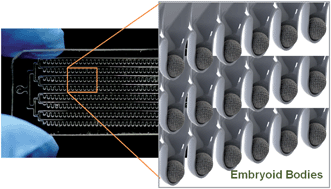Meniscus induced self organization of multiple deep concave wells in a microchannel for embryoid bodies generation†
Abstract
Embryonic stem cells (ESCs) have attracted great interest in the fields of tissue engineering, regenerative medicine, and organogenesis for their pluripotency and ability to self-renew. ESC aggregation, which produces an embryoid body (EB), has been widely utilized as a trigger of in vitro directed differentiation. In this paper, we propose a novel method for constructing large numbers of deep concave wells in PDMS microfluidic chips using the meniscus induced by the surface tension of a liquid PDMS prepolymer, and applied this chip for the mass production of uniform sized EBs. To investigate if the microenvironment in the deep concave well is suitable for


 Please wait while we load your content...
Please wait while we load your content...